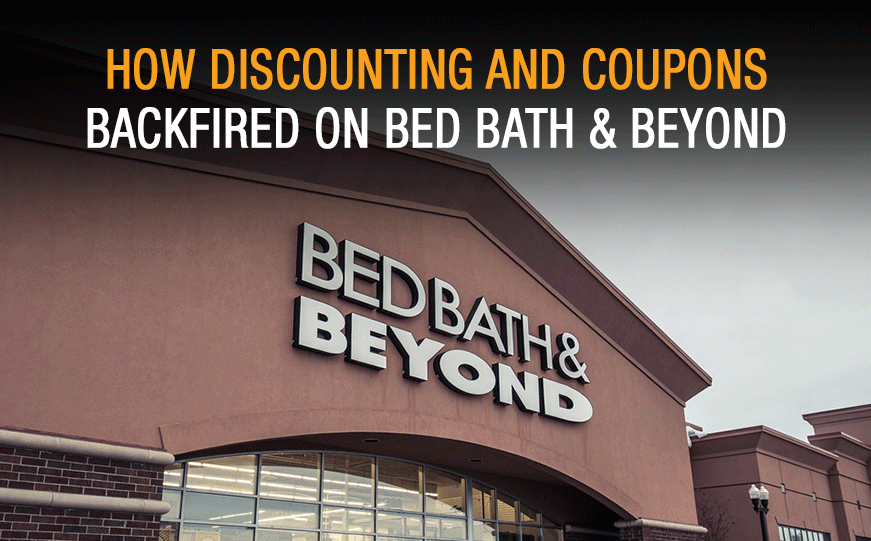Bed Bath & Beyond – a once-thriving home goods retailer – filed for bankruptcy on April 22, 2023. Important lessons can be learned in this cautionary tale… for marketing Building Product Brands.
What started as single store in Springfield, NJ grew into a “category killer” that completely changed the way home brands were sold. And how retail environments operated. Once a Wall Street darling, its long fall from grace came about for a host of reasons – and now as arm-chair-quarterbacks – allows us to harvest a wealth of important lessons.
Hooked on Discounts
One of Bed Bath and Beyond’s most enduring features was the near omnipresence of their 20% off coupons. When introduced, that campaign took on a life of its own. Many customers wouldn’t dream of shopping in a Bed Bath & Beyond store without one of those iconic coupons. Even sales support staff helped to download on-line versions for customers at check-out.
It’s clear that this reliance and brand “promise” came at a cost. The company’s former president, Arthur Starke, likened the promotions to a drug – and said that the company wasn’t able to reduce its couponing programs – without blowback from customers. “Once you’re addicted to it and your customer is addicted to it, it’s a very difficult thing to wean them off of,” he said.
Unfortunately, BB&B’s lowered margins helped drive retail prices down across the entire category. The retailer learned (too late) that it’s impossible to win in a race, to the bottom.
Of course, discounts can be a great way to attract new customers – and drive seasonal promotional campaigns – but they’re not particularly valuable tools for building a differentiation. Or for creating a sustainable brand offering.
Experience What Customers Experience
In any business environment, it’s vital to provide a unique, branded experience. Offering a variety of signature products or services. And then designing compelling reasons for your customers to do business together.
Bed Bath & Beyond’s customer experience was clearly subpar. In fact, the company’s stores were often cluttered and disorganized… with long wait times for service. And its website, difficult to navigate.
No business should allow a situation like this to progress so far.
Ask yourself, over-and-over again, “How does the experience of business with us… come across?” Make it a point to conduct website audits. And visit showrooms, supply counters and customer service departments. Honestly, would you do business with “you”?
Ignore E-commerce at Your Own Peril
The business landscape is constantly changing. So, it’s critical to stay focused and up-to-date on what customers are demanding. Understanding them – and being willing to adapt a business’ practices accordingly. When a brand or a supplier can stay ahead of the curve… it’ll be better positioned to succeed over time.
Bed Bath & Beyond was slow to adapt to a changing business landscape. The company’s stores were designed for an era… when audiences were much more likely to shop in person. However, as more and more people started shopping online, Bed Bath & Beyond’s stores became less relevant. Even so, BB&B never fully made the transition to e-commerce. And lost out on the biggest shift in retail sales. Ever.
One of the company’s founders admitted as much during a recent interview with The Wall Street Journal. “We missed the boat on the internet,” cofounder Warren Eisenberg told the Journal, later adding: “We didn’t realize fast enough how the internet would have such a major effect on retail.”
For two-step distribution, digital connections are important – for relationships with end-users – who do not use an on-line shopping cart. It’s a way to combine contextual signals with machine learning to engage consumers more deeply through highly targeted accuracy.
Learning from a set of business mistakes, it’s possible to avoid making similar missteps for Building Product Brands:
- Don’t rely on coupons – or a habit of discounts – for driving sales. Instead, focus on creating unique branded experiences. Offering a differentiated variety of products or services. And making it frictionless to do business.
- Stay up-to-date on trends. Understand what customers want and need. And be willing to adapt accordingly.
- Invest in technology. Systems can help to motivate customer desire. Streamline process. And realize new revenue.
- Be agile. The business landscape is constantly changing. Be prepared to respond and adapt.
When a well-known chain retailer goes under, it’s newsworthy.
Brands can endure. If and when… they’re led effectively. Often it is important to consider what not to do. As much as it’s important to keep thinking about the path forward.
If you’d like to talk about unique promotional strategies – designing differentiated customer experiences – and fine-tuning e-commerce practices, send an e-mail to Steve at sk@kleberandassociates.com to get the conversation started.




